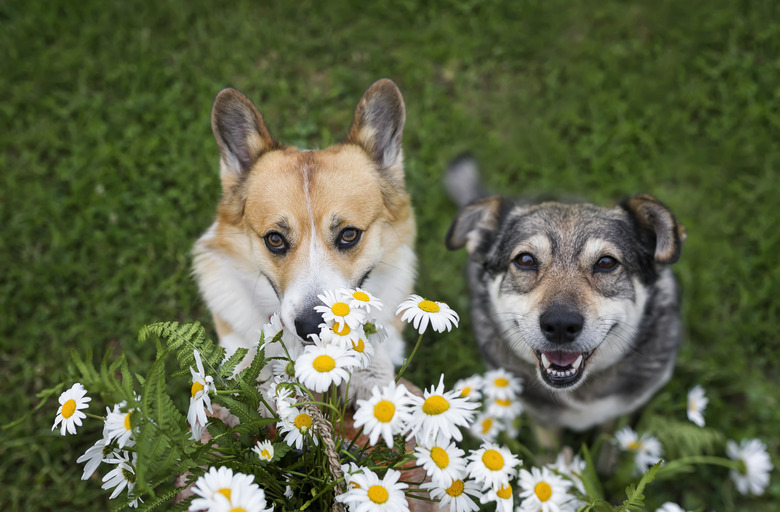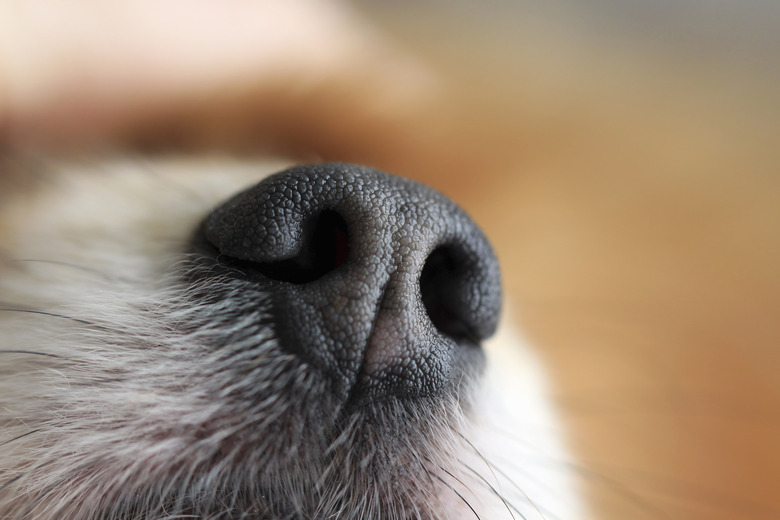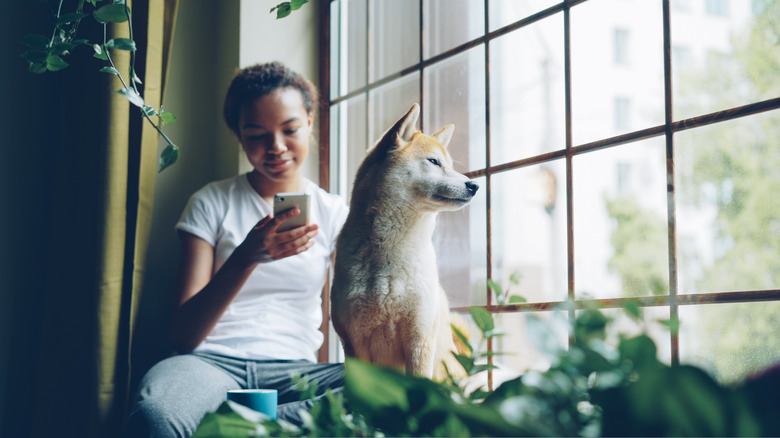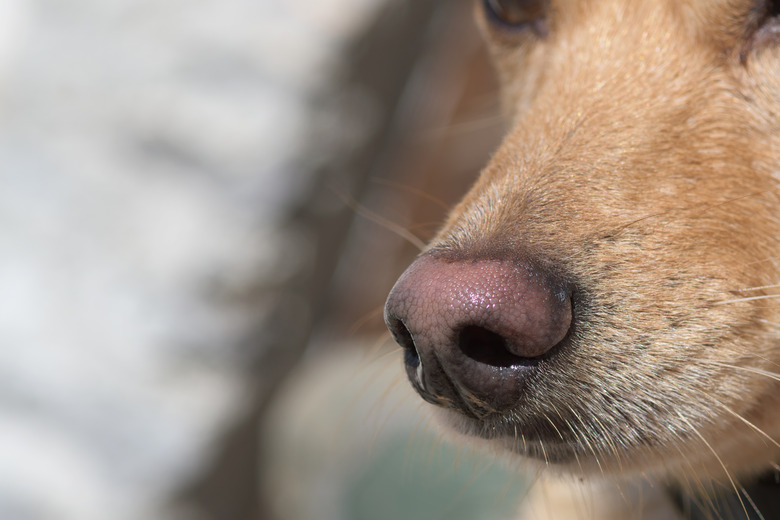How To Care For Cuts On A Dog's Nose
We may receive a commission on purchases made from links.
Cuteness may earn compensation through affiliate links in this article.
You know your dog has the cutest little nose! And you know what they mean when they communicate with their nose, like the way your dog pokes you with their nose whenever they want to play or the way they nudge you with their nose just to remind you that they are there. But their nose is also at risk of being injured from being used in so many ways. A cut on your dog's nose can cause pain for them and anguish for you if you don't know how to treat it properly.
Common causes of nose cuts on dogs
Common causes of nose cuts on dogs
Dogs explore the world with their nose, which can put them in many situations where their nose may be at risk of being damaged or injured. By recognizing the risks, a pet parent can take steps to try to prevent accidents and keep them safe.
Some of the more common causes of nose cuts on dogs include:
- Playing roughly
with other pets in your home - Fights or scraps
with another animal - Sticking their nose
somewhere that it doesn't belong - Eating or playing
with something sharp - Digging
- Nose rubbing due to
irritation from allergies - Other underlying
health problems
Some dogs can even injure their nose in a way that can only be described as a random accident, like not watching where they are going and running into a tree or other obstacle. While we can take steps to prevent injuries, we can't stop all accidents from happening. That's why it's so important to know how to treat cuts and scrapes when they happen.
Mistakes to avoid when treating a dog's cut nose
Mistakes to avoid when treating a dog's
cut nose
If your dog does have a cut on their nose, you should act quickly to clean it up and prevent infection. But there are a few more common mistakes that well-meaning dog owners make that should be avoided.
Don't get overly stressed out
Yes, there is a chance that your dog's cut looks very concerning. No one wants to see their pet injured, and this often triggers feelings of stress, fear, anxiety, or worry for dog lovers. But your dog feeds off your energy. If you're stressed out and anxious, they will be as well, making treatment more difficult. Take a deep breath and try to remain calm.
Avoid using hydrogen peroxide
Hydrogen peroxide is a go-to solution for human cuts and scrapes because it cleans wounds so effectively. As the hydrogen peroxide encounters an enzyme present in your dog's blood cells and tissue cells, it will start to bubble. In the past, we viewed this bubbling as a positive indication that the hydrogen peroxide is moving, but we now know that it is also causing damage. The bubbling is killing fibroblasts, or cells in your dog's body that are crucial to wound healing. The peroxide does help to disinfect the wound, but it also slows down your pet's natural healing process.
To clean the wound on your dog's nose, rinse the area with clean water if your dog will allow you to remove any dirt that may be in it. You can also clean the area around the wound with a soft washcloth and mild soap.
Don't give your dog human pain
medications
If you are dealing with any deep cuts, you may be concerned about the pain they are feeling. It may be tempting to reach for your over-the-counter pain medications to offer some relief, but many human pain medications are extremely dangerous for your dog. Don't give your dog any human medications unless you have been specifically directed otherwise by your veterinarian.
A step-by-step guide to treating a cut on a dog’s nose
1. Keep a first aid kit on hand
You'll have peace of mind if you already have a first aid kit on hand and you don't have to scramble to go to a store and purchase supplies. When your pet needs something, you'll already be prepared. Plus, a first aid kit is a great thing to have nearby if you have a pet sitter coming over who may not know where you keep your supplies. In your kit, keep ointments, cotton balls, bandages, gauze, a thermometer, scissors, tweezers, a magnifying glass, and a small towel. You can also pack other essentials like a bottle of water or an extra leash and flashlight.
2. Keep your dog calm
The first thing that you'll need to do if your dog gets a cut on their nose is to calm them down enough that you can get a good look at it and start treatment. If you've been working through obedience training with your dog, they may know a calming command like "settle" or "calm." This tells your dog to go to a designated spot, like their bed, and relax.
You may need to consider using a leash or something sturdy to help hold them still so that you can get a good look at their nose. If they are in pain, a muzzle can be used to prevent any injuries. Even the best-behaved dogs may react out of character when they are dealing with pain and discomfort.
Guardian Gear Fabric Mesh Muzzle is a great option that will let your dog breathe, eat, and drink easily while wearing it and allows you to have easy access to examine their nose.
3. Stop the bleeding
If your dog has an open wound on their nose, it could bleed a lot because the face has a lot of blood supply. That can lead to a scary situation for both you and the dog. If there is blood, control any bleeding by using firm but gentle pressure with a clean towel or washcloth. If needed, you may also use a clean cotton swab to dab on some Remedy + Recovery Styptic Blood Stopper Powder to help with clotting to stop the bleeding. However, this should not be put in deep cuts that need stitches.
If you are dealing with bite wounds, the animal responsible for the bite could directly impact the amount of bleeding. A dog who is bitten by another dog will bleed more than a dog who has been bitten by a cat due to the shape of their teeth. Dog bites tend to be more surface bites that cause tearing of tissue, whereas bites from cats tend to be deeper puncture wounds, which also cause more concern about infection.
If the cut is deep or will need stitches or if you have difficulty stopping the bleeding, contact your veterinarian immediately.
4. Protect the wound
Dogs don't have lip balms in their pocket that they can put on their nose as we do for our dry lips. To keep the tender skin on their nose moist and not dry and cracked, dogs lick their nose. But when your dog licks their injury, they may be introducing bacteria to the wound or keeping the tender skin so moist that it can't heal properly.
Wounds on a dog's nose can be difficult to bandage, which makes sense because your dog is always using their nose to explore. It's also a shape that can make it difficult to wrap or attach a bandage. A gauze pad held on by adhesive tape is unlikely to stay in place.
Instead, keep the cut clean and keep applying ointment to keep it moist. If your dog paws at it, use an e-collar, otherwise referred to as a cone, to prevent them from being able to reach it. Fabric or inflatable e-collars, like the Comfy Cone e-collar, can be folded and reversed to keep your dog's paws away from the injury while allowing a full range of vision and the ability to eat and drink normally.
The regular plastic e-collars also work well at preventing your dog from reaching their nose. However, this style of e-collar is made from a more rigid material and purposefully extends beyond the nose. You may need to elevate your dog's food and water bowls to help them more easily eat and drink, or you can take off the cone for mealtimes, but water bowls may still need to be propped up to ensure that your dog has ongoing access to fresh water.
5. Make an appointment
with your veterinarian
Even though you're performing basic first aid at home, you'll want to have a veterinarian look at your dog's nose. Although your dog's cut may not seem serious, it could be worse than it looks. If the bite area is large, there is a lot more potential for bacteria to get into the wound and cause an infection. An appointment with your veterinarian will allow them to check for any potential problems and get the wound into good shape so that you can continue your home care until it heals.
If you notice any signs of infection such as discharge, contact your veterinarian immediately to discuss treatment. They may prescribe oral antibiotics or an antibiotic ointment to fight the infection.
Is it OK to use Neosporin on a dog’s nose?
Is it OK to use Neosporin on a dog's
nose?
Yes, it is OK to apply an antibacterial ointment like Neosporin to your dog's wound. The same applies to the use of Vaseline. But you should try to prevent your dog from licking off the ointment. Ingesting Neosporin or Vaseline could upset your dog's intestinal flora or the normal bacteria in their gut, causing nausea, vomiting, or diarrhea.
A better choice to care for cuts on a dog's nose is Honey Cure, which contains medical-grade honey which is naturally anti-microbial and is completely nontoxic to pets. The formula includes ingredients that help to combat itching, and it is specifically labeled as safe to use on your dog's nose as well as around the mouth and ears.
The bottom line
The bottom line
If your dog injures their nose, make sure that everyone remains calm (including you). Stop bleeding in the area by using firm but gentle pressure or with the help of styptic powder. If you notice your dog pawing at their nose, consider using an e-collar to protect it from further damage. You can also use a pet-specific antimicrobial gel to protect the area and soothe itching. Make an appointment with your DVMn to prevent any unseen problems and to help the wound heal properly.



